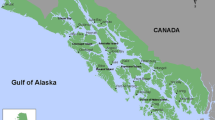Abstract
This paper proposes contingent behavior survey questions as a valuable supplement to observed data in travel cost models of non-market demand for recreational resources. A set of observed and contingent behavior results for each survey respondent allows the researcher to control for individual heterogeneity by taking advantage of panel data methods when exploring the nature of respondent demands. The contingent scenarios also provide opportunities to (a) test for differences between observed and contingent preferences and/or (b) assess likely demands under conditionsbeyond the domain of observed variation in costs or resource attributes. Most importantly, contingent scenarios allow the researcher to imposeexogenously varying travel costs. Exogenous imposition of travel costs together with panel methods reduces the omitted variables bias that plagues observed-data travel cost models of recreational demand. Using a convenience sample of data for illustrative purposes, we show how to estimate the demand for recreational angling by combining observed and contingent behavior data. We begin with simple naive pooled Poisson models and progress to more theoretically appropriate fixed effects panel Poisson specifications.
Similar content being viewed by others
References
Adamowicz, W., J. Louviere and M. Williams (1994), ‘Combining Revealed and Stated Preference Methods for Valuing Environmental Amenities’,Journal of Environmental Economics and Management 26(3), 215–234.
Allen, P. G., T. H. Stevens and S. A. Barrett (1981), ‘The Effects of Variable Omission in the Travel Cost Technique’,Land Economics 57(2), 173–180.
Bockstael, N., W. M. Hanemann and I. Strand (1984),Measuring the Benefits of Water Quality Improvements Using Recreational Demand Models. Volume II of Benefit Analysis Using Indirect or Imputed Market Methods, EPA Contract No. CR-811043-01-0 (1984).
Cameron, T. A. (1992), ‘Combining Contingent Valuation and Travel Cost Data for the Valuation of Nonmarket Goods’,Land Economics 68(3), 302–317.
Caulkins, P. P., R. C. Bishop and N. W. Bouwes (1985), ‘Omitted Cross-Price Variable Biases in the Linear Travel Cost Model: Correcting Common Misperceptions’,Land Economics 61(2), 181–187.
Cummings, R., D. Brookshire and W. Schulze (1986),Valuing Environmental Goods: A State of the Arts Assessment of the Contingent Valuation Method, Rowman and Allanheld, Totowa, N.J.
Dickie, M., A. Fisher and S. Gerking (1987), ‘Market Transactions and Hypothetical Demand: A Comparative Study’,Journal of the American Statistical Association 82, 67–75.
Gourieroux, C., A. Monfort and A. Trognon (1984), ‘Pseudo Maximum Likelihood Methods: Applications to Poisson Models’,Econometrica 52(3), 701–720.
Hall, B., Z. Griliches and J. Hausman (1986), ‘Patents and R&D: Is There a Lag?’,International Economic Review 27(2), 265–284.
Hausman, J., B. Hall and Z. Griliches (1984), ‘Econometric Models for Count Data with an Application to the Patents-R&D Relationship’,Econometrica 52(4), 909–938.
Hellerstein, D. (1991), ‘Using Count Data Models in Travel Cost Analysis with Aggregate Data’,American Journal of Agricultural Economics 73(3), 860–867.
Hellerstein, D. (1992), ‘The Treatment of Nonparticipants in Travel Cost Analysis and Other Demand Models’,Water Resources Research 28(8), 1999–2004.
Hellerstein, D. (1993), ‘Intertemporal Data and Travel Cost Analysis’,Environmental and Resource Economics 3(2), 193–207.
Kling, C. L. (1989), ‘A Note on the Welfare Effects of Omitting Substitute Prices and Qualities from Travel Cost Models’,Land Economics 65(3): 290–296.
McKean, J. R. and C. F. Revier (1990), ‘Omitted Cross-Price Variable Biases in the Linear Travel Cost Model: Correcting Common Misperceptions: An Extension’,Land Economics 66(4), 430–436.
Mitchell, R. and R. Carson (1989),Using Surveys to Value Public Goods: The Contingent Valuation Method, Resources for the Future, Washington, DC.
Randall, A. (1994), ‘A Difficulty with the Travel Cost Method’,Land Economics 70(1), 88–96.
Wilman, E. A. and J. Perras (1989), ‘The Substitute Price Variable in the Travel Cost Equation’,Canadian Journal of Agricultural Economics 37(2), 249–261.
Author information
Authors and Affiliations
Additional information
The authors are at the University of Nevada and UCLA, respectively. We gratefully acknowledge the comments of both Scott Shonkwiler and participants in the W133 meetings in Santa Fe, New Mexico and for research material provided by Wayne Gray. The data were provided by Rang Narayanan. Research assistance was provided by Jerry McGraw and Natalie Tucker. Research partially supported by the Nevada Experiment Station. Any errors or omissions remain the authors' responsibility.
Rights and permissions
About this article
Cite this article
Englin, J., Cameron, T.A. Augmenting travel cost models with contingent behavior data. Environ Resource Econ 7, 133–147 (1996). https://doi.org/10.1007/BF00699288
Issue Date:
DOI: https://doi.org/10.1007/BF00699288




